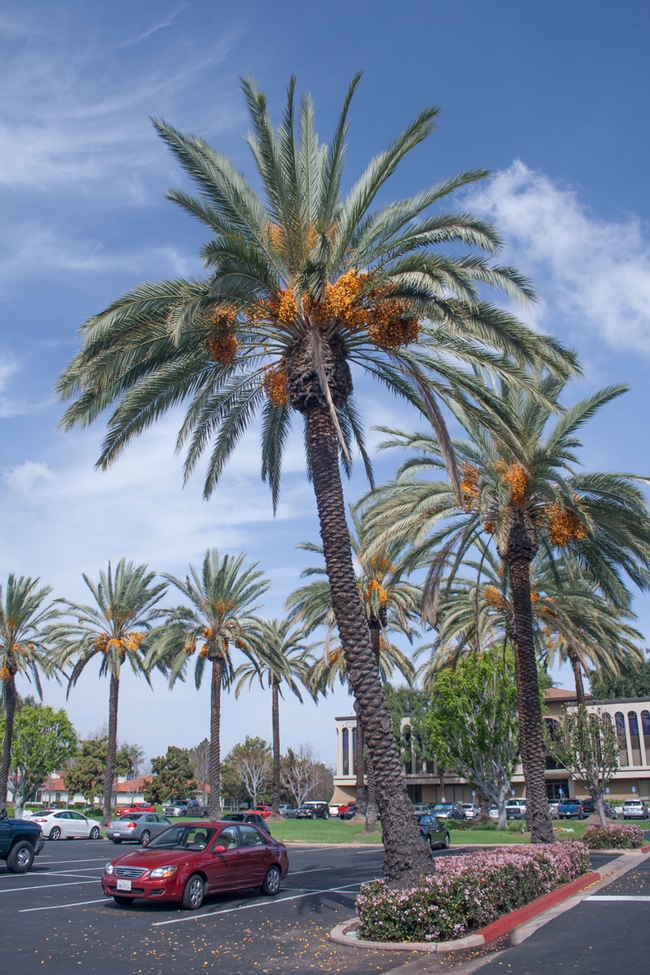Ornamental landscape date palm: An overlooked urban fruit tree
One fruit, though, is not on the radar of foodies and foragers. Yet it's crunchy, sweet, flavorful, often seedless, and very common in Southern California landscapes. It's the fruit of the date palm, rarely thought of as a food source in our urban environment, more frequently viewed as a nuisance because dates fall off trees, where they create litter that must be cleaned up.
Unfortunately, coastal Southern California lacks the high sustained heat and aridity for proper fruit maturation and curing to produce traditional soft-ripe dates of good eating quality. The dates that fall from the trees have been unattractive to gather for sale and consumption, processes that could help to resolve the fruit litter problem in the landscape.
However, some varieties of dates can be eaten at a less than a mature state, traditionally called “khalal.” Fruit in the khalal stage have attained their maximum size, are typically yellow or red, have a sweet flavor, and are crunchy, somewhat like an apple. Several date varieties, like ‘Barhee,' are sometimes sold and eaten in the khalal stage. Fortunately, from a food standpoint (or unfortunately if you are a landscape manager), date fruits do mature to the khalal stage in coastal Southern California because high sustained heat and aridity are not required to attain this stage of development.
While ‘Barhee' is not too common as a landscape subject, another variety, ‘Zahidi,' is common and typically produces abundant fruits in coastal Southern California. These golden yellow fruits are conspicuous and showy in the khalal stage, are typically on the palm for several months from late fall to spring, and are really good to eat. Also, in many cases, these fruits are seedless! (Note to horticulture geeks: date palms are dioecious - separate male and female trees - and because nearly all edible date palms in the landscape are female, their flowers were pollinated by other species of landscape Phoenix. The resulting hybrid fruits are seedless, or pollination is not required for fruit to set and develop - parthenocarpy.)
Urban foragers looking for their next food adventure, or even a potential enterprise, might want to consider taking advantage of this otherwise nuisance and unwanted fruit. Khalal fruit can be gathered from the ground and cleaned. But it is best to collect them off the palm. Cutting an inflorescence (entire fruit stalk) and lowering it carefully to the ground would be ideal.

Khalal-stage fruits of the date variety ‘Zahidi’ are really good to eat: crunchy, sweet, and flavorful. Also, they are seedless (D. R. Hodel).
Comments:
I grew a date palm from store bought dates, it made up to 5 adult leaves, when i noticed the pot being too small. So i repotted it in a huge container.
It did not grew anymore for 2 years,
Now it starts growing again, it made a new leaf, and it is a lot smaller, the previous are twice as big.I hope he will pick up its usual growt.
I live in the netherlands and winters are too cold to put it in soil in the garden.
So when winter comes i keep it in a greenhouse at 59 fahrenheit.
The question is, is it possible to grow n nice tree this way?
I know harvesting dates wil never happen, and they become really big,but just information about how to care for P.Dactylifera is rare, i never found any, only thing i find, is info for date farming, nothingabout care for dates as potplants in colder regions.
Sorry for my elaborate story,i hope it is not full of mistakes, because english is not my native language.
I am very curious, so i really hope someone has a clue about growing them in colder regions, already thanks, Pat.
Yes, palms can be grown indoors in cold temperate climates like northern Europe. Select palms that grow slowly and/or do not get too big and can tolerate extended periods of low light and low humidity, like Chamaedorea (bamboo palms) and Rhapis. Date palm (Phoenix dactylifera) will grow indoors but needs lots of light, even direct sunlight, for much of the day. Consider artificial lights for additional light, especially in the winter. Keep soil evenly moist, not too wet; you can even let it dry out slightly before applying water again. Apply a slow-release fertilizer once a year. Watch for insect pests like ants, scales, and mealy bugs.
Have a sick date palm in Florida.
They state the soil should be a pH of 8 to 10.
I have put tea leaves around it? This wrong?
I assume it could have acidified it.
What would use to alkalize it? They state not to us calcium.
What also would be a good general fertilizer?
Thank you!




Posted by Peg Ordway on April 1, 2014 at 6:21 AM